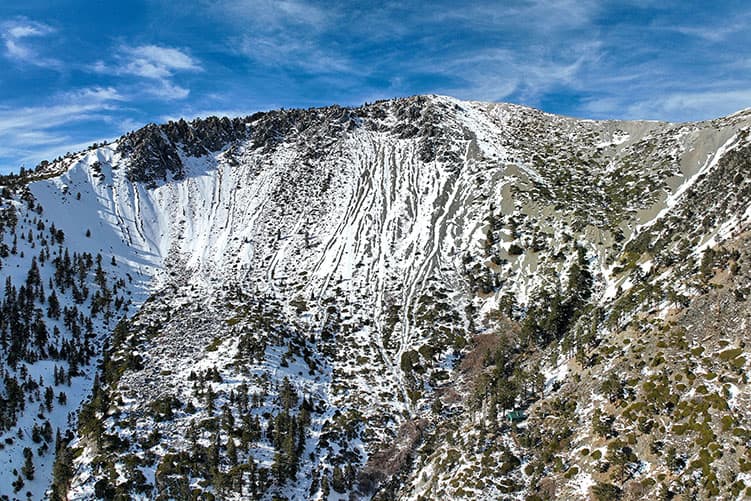The real dangers of hiking Baldy Bowl in winter

by Peter Weinberger | pweinberger@claremont-courier.com
I was a 16-year-old kid who loved hiking and had trekked up to Mt. Baldy many times. I’d hiked all the routes, in all seasons, even in the dead of winter. When I had an opportunity to climb Mt. Baldy’s summit (at 10,064 feet) with experienced hikers on a cold weekend in January, I jumped at the chance. It was an experience I never forgot.
The main trail up to the Baldy summit begins as a well-marked service road and circles east to the top of the ski lifts and the Mt. Baldy Notch. From there, the trail is steep, heading north and then west to the summit. It’s a six-mile mile trek, climbing about 3,500 feet.
Many hikers prefer a popular plan B that takes a more direct route to the Baldy summit. In winter this is the only way to reach the top. It’s shorter and even steeper, heading directly north from the service road right up to Baldy Bowl, sitting 2,000 feet directly under the summit. It cuts about 2-miles off the journey to the top of the mountain.
Hiking to the top
The trail up to the 8,500-foot Baldy Bowl is challenging and beautiful, but suited only for experienced, very well-conditioned hikers. The problems start when inexperienced hikers decide to summit Baldy by crossing the bowl west, then head north up steep mountain sides where snow gear (crampons and ice pick just to start) are needed.
When I summited the mountain as a naïve teenager, I had all the gear and experience help to complete the journey. As I reached over 9,000 feet the weather started to change dramatically, the sunny 50-degree temps dropping to near freezing, with a wind that only got stronger the higher I climbed.
As we all know, walking in snow takes an enormous amount of energy and conditioning, made much more difficult when negotiating steep terrain. It didn’t take long before winds were whipping snow right through me, producing whiteout conditions. A half mile from the top, I was exhausted and concerned I not only could not continue, but literally would be blown off the mountain. What had started out as a dry, snowless trail, had turned into a nightmare where I literally feared for my life.
I was lucky to be with such experienced climbers, who made sure I was safe as we summited Baldy and eventually built a small igloo that protected us (it’s also soundproof) from the elements for our overnight stay.
A story and pictures of the journey appeared in the Courier a week later. I had done my job and lived to report it. Needless to stay, I never used this route to hike Baldy again in the winter, only visiting Baldy Bowl in the summer.
Nothing has changed
Today we have a story of yet another person who was killed hiking around the Baldy Bowl area. It’s a problem that will obviously never go away. Imagine a person hiking up Mt. Baldy through the bowl, some prepared for the elements, others not. The snow gets deeper, the trail is lost, then the wind and cold kick in. It’s a recipe for disaster that has plagued the mountain for decades.
Yet there are still people who just used this route between rainstorms hitting Southern California over the past two weeks. On the All Trails hiking app, recent comments include hikes interrupted by dangerous conditions. For every person who said the trip was great, there were four others talking about the challenges or mishaps of their climb. These experiences were so similar to mine 50 years ago, I got a case of deja vu.
I cringed when reading these accounts. Unfortunately, if there’s a beautiful mountain to climb, people will attempt to reach the summit.
I really don’t know how many must lose their lives before people realize this hike is not safe. One slip, one fall, and you can roll down a thousand feet over large rocks to your death. Some may think I’m overreacting, but I’ve been there, and can honestly recommend that in the snow, please sit this hike out.









0 Comments